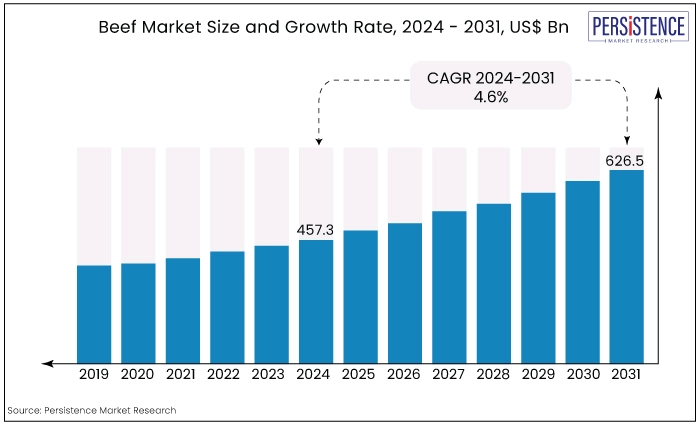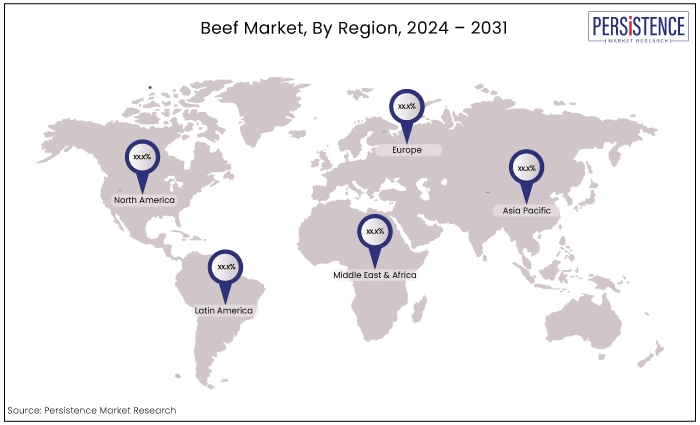Industry: Food and Beverages
Format: PPT*, PDF, EXCEL
Delivery Timelines: Contact Sales
Report Type: Ongoing
Report ID: PMRREP34661
The beef market report estimates the market at US$457.3 Bn towards the end of 2024 and anticipates it to reach US$626.5 Bn by 2031. The market for beef is expected to reach an increasingly steady CAGR of 4.6% from 2023 to 2031.
Key Highlights of the Market
|
Attributes |
Key Insights |
|
Market Size (2024E) |
US$457.3 Bn |
|
Projected Market Value (2031F) |
US$626.5 Bn |
|
Global Market Growth Rate (CAGR 2024 to 2031) |
4.6% |
|
Historical Market Growth Rate (CAGR 2019 to 2023) |
4.0% |
The market is a significant sector of the global food industry, driven by factors such as consumer preferences, increasing fitness-conscious people, and awareness about beef benefits. The market for beef is held at US$ 457.3Bn in 2024. The market is continuously pushing the boundaries.
The beef market trends, such as the shift towards sustainable practices, technological innovations, and awareness about beef benefits for health, have boosted the market.
Increasing fitness-conscious people are interested in healthy grass-fed and organic beef which are healthier and ethically sourced food options, which are expected to push the market sales significantly.
Further, changing dietary habits and consumer preferences favor food products with low fat, calorie content, and high protein value. The utilization of beef in the food industry, including burgers, hotdogs, sausages, steaks, and stews, contributes to beef market growth.
Other factors include rising income among middle-class consumers in developing countries, demand for convenience foods, and the market scope for ready-to-eat meat products due to busy schedules.

The market has experienced significant growth over the years, driven by various factors such as changing consumer preferences, dietary habits, rising disposable income, and awareness about the benefits of beef.
A comprehensive market report shows substantial growth in the market, with a market size expected to reach US$ 626.5 Bn by 2031. This growth is attributed to factors such as increasing consumer inclinations and the demand for high-quality beef.
People across the globe show growing preference for premium and high-quality beef with labels such as Certified Angus Beef (CAB), USDA Choice, USDA Natural, and USDA Prime.
Consumers are becoming more conscious of the negative health impacts associated with the consumption of meat products composed of growth-enhancing hormones and antibiotics. This trend is driving the demand for high-quality beef meat.
The beef industry is expected to continue its growth trajectory. The "Global Wagyu Beef Market Report 2023" predicts impressive expansion in the Wagyu beef industry, with an anticipated increase from $2.18 billion in 2022 to $2.35 billion in 2023, reflecting a CAGR of 7.8%. Furthermore, the Wagyu beef market is projected to reach $3.07 billion by 2027, with a CAGR of 6.8%.
Increasing Demand for Nutritious and Protein-Rich Meat Products
The market is experiencing growth due to the increasing consumer demand for nutritious and protein-rich meat products. Beef is widely recognized as a valuable source of essential nutrients and protein, making it a popular choice among consumers.
This demand stems from the understanding that beef plays a crucial role in maintaining a balanced diet and promoting overall health and wellness. As a result, the beef industry continues to thrive as consumers prioritize the consumption of nutritious meat products.
Shift Towards Premium and High-Quality Beef
There is a noticeable trend towards premium and high-quality beef products. Consumers are becoming more conscious of the quality and sourcing of their food, leading to an increased demand for beef with labels such as Certified Angus Beef (CAB), USDA Choice, USDA Natural, and USDA Prime.
Technological Advancements and Product Innovation
Technological advancements and product innovation play a significant role in driving the growth of the market. Companies in the industry are adopting strategies to enhance production processes, improve product quality, and meet consumer preferences. This includes the adoption of sustainable practices, advancements in packaging, and the development of alternative proteins.
Climate Change, and Environmental Concerns
Climate change and environmental concerns pose significant challenges to the market. The beef industry has been criticized for its high greenhouse gas emissions, deforestation associated with cattle ranching, and water usage.
Increasing awareness and regulations regarding sustainability and environmental impact are impeding the market's growth and forcing industry players to adopt more sustainable practices.
Dietary Shifts
Shifting consumer dietary preferences and health concerns are impeding the market. Some consumers are opting for plant-based or alternative protein sources due to health considerations, ethical concerns, or dietary restrictions.
The rising popularity of vegetarian, vegan, and flexitarian diets is impacting beef consumption. Additionally, health concerns related to red meat consumption, such as its association with certain health conditions, are influencing consumer choices.
Demand Surge in Developing Countries
The beef market has significant growth potential in developing countries, particularly in Asia, and Latin America. Rising middle-class incomes in these regions, coupled with changing dietary preferences and an increasing demand for animal-sourced protein, present opportunities for the beef industry to expand its market share.
Expanding Market for Grass-fed Beef
The popularity of grass-fed beef is driven by consumer preferences for more sustainable and ethically produced meat. Grass-fed beef is perceived as healthier and more environmentally friendly, leading to increased demand. Producers who can meet the requirements for grass-fed certification and cater to this niche market have the potential to capitalize on this opportunity.
Innovation in Value-Added Beef Products
The market can benefit from innovation in value-added products. This includes the development of ready-to-eat beef snacks, convenient meal solutions, and premium cuts with specific attributes such as marbling and tenderness. By offering differentiated and value-added products, the beef industry can cater to evolving consumer preferences and capture new market segments.
Loin Beef is Leading the Market with its Robust Popularity
Based on product type, the loin segment dominated the market in 2022, holding the largest market share. Loin cuts in the market are currently experiencing a surge in popularity, with cuts like ribeye and tenderloin being highly sought after for their tender texture and rich flavor. Consumers are willing to pay a premium for these high-quality options.
On the other hand, the brisket segment is expected to witness the highest CAGR during the forecast period in the market. Brisket is now being featured in a variety of culinary creations, showcasing its versatility and appeal.
Ground Beef Segment at the Forefront
Based on cut type, the ground beef segment dominated the market in 2022, holding the largest market share. Ground beef continues to be a staple in the beef market, valued for its versatility and convenience.
Notably, there is a growing demand for leaner varieties of ground beef as health-conscious consumers seek healthier options.
On the other hand, cubed beef, typically sourced from cuts like chuck or round, is gaining popularity in the market. Its convenience and versatility make it well-suited for quick cooking methods such as stir-frying and kebabs, which align with the busy lifestyles of many consumers.
Supermarkets and Hypermarkets Take the Lead
In terms of distribution channels, the supermarkets and hypermarkets segment emerged as the market leader in 2022, holding the largest market share.
Supermarkets and hypermarkets maintain their dominance in the beef market share distribution channel, attracting consumers with their convenient locations and extensive product offerings.
North America Offers the Strongest Breeding Ground
North America is one of the biggest regions that entails consumers of beef in the global market. North America, including the US, and Canada, is another important region for the beef market.
Among these, the US is the biggest consumer of beef, with consumption averaging around 67 pounds per person per year. Additionally, the US is the world's top producer of beef and veal, with production exceeding 12.6 million metric tons in 2022.
Asia Pacific Boosting the Beef Market with Largest China's Consumer Landscape
Asia Pacific region is the second-highest region that accounted for a significant revenue share of the global beef market, ranging from 47.8% to 48.0% in recent years.
The Asia Pacific region, particularly China, India, Japan, and Australia, represents key markets for beef. China, in particular, is one of the largest markets for beef, experiencing significant growth in demand.
The rising middle-class incomes, changing dietary preferences, and increasing demand for animal-sourced protein contribute to the growth of the market in this region.
Europe Paving the Way for Beef Market Expansion with Food Innovations
Europe is an important market for beef as it is experiencing growing demand for halal-certified beef. This growth is driven by the increasing beef consumer population in this region.
Additionally, the region has seen new product developments in the meat market, including protein-rich launches and options with reductionism claims. The region is expected to witness steady growth in the demand for fresh meat and grass-fed beef.

February 2024
Beyond Meat is a company that has gained recognition for its plant-based meat alternatives. They have developed innovative products that aim to replicate the taste and texture of traditional beef using plant-based ingredients. Beyond Meat's focus on creating sustainable and environmentally friendly meat alternatives has contributed to advancements in the beef industry.
December 2023
Impossible Foods is launching its latest meat-from-plants innovation, Impossible™ Beef Hot Dogs, for one day only in New York City. The hot dogs, made with high-quality ingredients derived from plants, offer a fresh take on the classic American hot dog, with 50% less total saturated fat than a leading brand of animal beef hot dogs. Impossible Hot Dogs account for 84% less greenhouse gas emissions, 77% less water, and 83% less land than an animal beef hot dog. The company has released seven new products in the last 12 months, including the Impossible™ Indulgent Burger, Impossible™ Beef Lite, and Impossible™ Spicy Chicken Nuggets & Patties.
Competitive Landscape Analysis
The beef market is experiencing rapid growth, as highlighted by the market report. Industry players are introducing new products and incorporating innovative technologies to capitalize on emerging opportunities.
These companies are implementing key strategies to expand their portfolio, increase market share across regions, invest in research and development, expand internationally, and optimize supply chains, all aimed at boosting their market value.
|
Attributes |
Details |
|
Forecast Period |
2024 to 2031 |
|
Historical Data Available for |
2019 to 2023 |
|
Market Analysis |
US$ Billion for Value |
|
Key Country Covered |
|
|
Key Market Segments Covered |
|
|
Key Companies Profiled |
|
|
Report Coverage |
|
|
Customization & Pricing |
Available upon request |
By Cut Type
By Distribution Channel
By Product Type
By Geographical Regions
To know more about delivery timeline for this report Contact Sales

The market is predicted to rise from US$457.3 Bn in 2024 to US$626.5 Bn by 2031.
Increasing demand for nutritious and protein-rich meat products, shift towards premium and high-quality beef, and technological advancements and product innovation are propelling market growth.
Fujitsu, Citrix Systems, Atos SE, Fujitsu Limited, Inc., and IBM are some major industry players.
Climate change and environmental concerns and dietary shifts to vegan and vegetarian foods are restraining market expansion.
Growing demand in developing countries, an expanding market for grass-fed beef, and innovation in value-added beef products are the major factors creating opportunity in the market.